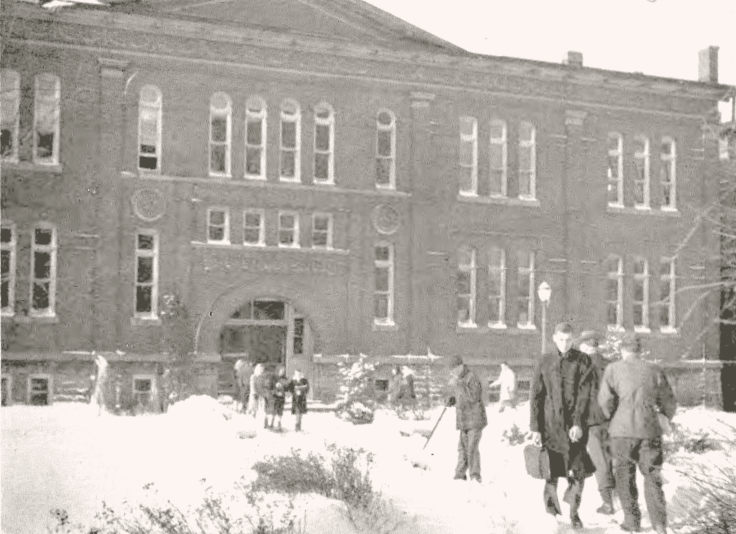Pointing out one of her techniques on an out-size acrylic she is working on is Harriet Rex Smith, well-known local artist who will be one of 120 exhibitors this year at the Chesterton Art Fair. Also involved in the Association of Artists and Craftsmen of Porter County project since its actual inception during the Chesterton Centennial are Evelyn Finnstrom, center, and Hazel Hannell, standing, both of Chesterton.
This story by Dorothy Eagen originally appeared in The Vidette-Messenger on July 26, 1973.
"I remember the days years ago, when we held the first art fair at the Porter County Fairgrounds, Mrs. V.M.S. Hannell conversationally noted, in reminiscing about the annual Chesterton Art Fair. “I also recall the large tent fair that we held two years later at Railroad Park in Chesterton, when the doors were locked on the facilities, when the hardest working committee was the clean-up group, who spent a day picking up bubblegum wrappers and kleenex out of the bushes,” quipped Ms. Harriet Rex Smith, who along with Ms. Hannell and Ms. Evelyn Finnstrom, local artists have been exhibiting and involved in the event ever since its inception.
Today, they are busily preparing for the 15th such affair, to be held Aug. 4 and 5 at St. Patrick's School in Chesterton, where it has been held since 1964.
The fair has been held beneath shade trees in the school yard, complemented by meals prepared and served by women of St. Patrick's School and has been attended by thousands of spectators and art buffs who travel each year to the two-way event from over a four-state area.
A popular and much respected fair where artists of all media and craft congregate once a year, all entries are juried and have been since 1963. Individual booths casually scattered about the grounds house each individual artists' exhibit. Tables are usually laden with sculpture, craft items and often are flanked with large art articles.
Another appeal is its dauber's booth, its pony rides for children, its casual grouping of exhibits and generally relaxed browsing atmosphere. It's a family affair where often the entire day is spent.
The fair has been sponsored by the Association of Artists and Craftsmen of Porter County, whose beginnings date back to the late ‘30s.
Twenty years later, they organized calling themselves the Porter County Art Association co-sponsored by the Chesterton Retail Merchants. By 1958 they had their constitution written and were on their way to being the current organization which today operates Gilbert Gallery on Fourth Street in Chesterton.
Proceeds from the fair are used to maintain the gallery and to help further provide the community with an art center boasting classes and area for exhibit.
Three of the most notable local artists who have been exhibiting a at the fair and instrumental in its progress to date as past officers, committee chairmen, publicity heads, and general coordinators are Harriet Rex Smith, County Road 700 N; Hazell Hannell and Evelyn Finnstrom, both of Chesterton.
Multiple-Award Winner Smith is a teacher, affiliated with several art centers; is an affiliate of four galleries both in the midwest and on the east coast, who earned her art degrees at Indiana University and the University of Notre Dame.
She has held numerous one-man shows around the area and in Chicago, Gary, Hammond, and Michiana Shores and most recently won the Best of Show in the Northern Indiana Art Salon, Hammond; First painting with Southern Shores Art Exhibition, Gary; First Prize at the Indianapolis Museum of Art.
She has presented numerous lectures on art and technology, portrait demonstration. Divorced, she has seven children with one son a student at Valparaiso University.
Formerly of Illinois, Mrs. Hannell and her late husband moved to Indiana in 1930 and to a studio they built on five acres of Duneland property.
Born in LaGrange, she studied at the Chicago Art Institute, Church School of Art, and American Academy. Her husband, the late V.M.S. Hannell also an artist and sculptor of note, later erected a pottery where they both worked making informal tableware and decorative accessories which have had national distribution in leading shops. Adjoining the pottery, they maintained an art gallery open to the public where they exhibited their paintings, pottery, and sculpture.
In 1952, during the Chesterton Centennial, they helped promote the first tent show art exhibit. Later they were active in organizing the AACPC and were host to many of the meetings. Both were at times chairmen of the outdoor fair. Since his death in 1964, she has continued operation of the pottery and gallery, still paints and exhibits in local and national shows.
Aside from her vocation as an artist, Evelyn Finnstrom pens The Vidette-Messenger's "Cultural Corner” and is employed in the Voter Registration Office at the Porter County Courthouse.
While serving for 10 years as treasurer of AACPC, she has held one-man shows at several galleries, has exhibits at the courthouse, new county jail building, and the Chesterton License Bureau.
She has exhibited at Minas Galleries in Hammond; Indiana University Northwest, Lowell; Valparaiso, Michigan City, Dunes, St. Joe, Michigan City Dunes Art Fair, and Chesterton Art Fair, then known as the Tent Show back in the Railroad Park.
Her colleague, Mrs. Smith, was one of her instructors, as well as Frances Milam Jensen, Ethel Crouch, Brown Bergstrom Templeton, the Chicago Art Institute Summer School of Painting.
These three artists will join more than 120 other juried artists this year in the 15th Chesterton Art Fair.








